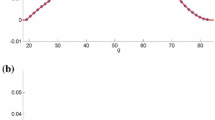Abstract
Statistical methods are commonly used to evaluate natural populations and environmental variables, yet these must recognize temporal trends in population character to be appropriate in an evolving world. New equations presented here define the statistical measures of aggregate historical populations affected by linear changes in population means and standard deviations. These can be used to extract the statistical character of present-day populations, needed to define modern variability and risk, from tables of historical data that are dominated by measurements made when conditions were different. As an example, many factors such as climate change and in-channel structures are causing flood levels to rise, so realistic estimation of future flood levels must take such secular changes into account. The new equations provide estimates of water levels for “100-year” floods in the USA Midwest that are 0.5 to 2 m higher than official calculations that routinely assume population stationarity. These equations also show that flood levels will continue to rise by several centimeters per year. This rate is nearly ten times faster than the rise of sea level, and thus represents one of the fastest and most damaging rates of change that is documented by robust data.
Similar content being viewed by others
References
Belt, C. B., 1975. The 1973 Flood and Man’s Constriction of the Mississippi River. Science, 189: 681–684
Chow, V. T., 1964. Handbook of Applied Hydrology. McGraw-Hill, New York. 8: 23
Criss, R. E., Shock, E. L., 2001. Flood Enhancement through Flood Control. Geology, 29: 875–878
Criss, R. E., Winston, W. E., 2008. Public Safety and Faulty Flood Statistics. Environmental Health Perspectives, 116(12): A516. doi:10.1289/ehp.12042
Criss, R. E., Kusky, T. M., 2008. Finding the Balance between Floods, Flood Protection, and River Navigation. [2013-10-12]. http://ces.slu.edu/annualreport/FloodForum_Book_final.pdf(2008)
FEMA, 2011. Flood Insurance Rate Map, City of St. Louis, Missouri. Map Number 2903850068C, May 24, 2011
FEMA, 2006. Flood Insurance Rate Map, Jefferson County, Missouri. Map Number 29099C0025E, April 5, 2006
FEMA, 2009. Flood Insurance Rate Map, Alexander County, Illinois. Map Number 17003C0220E, May 4, 2009
FEMA, 2013. Flood Insurance Rate Maps, Various Sites and Years. [2013-10-12]. https://msc.fema.gov/webapp/wcs/stores/CategoryDisplay?catalogId=10001&storeId=servlet/10001&categoryId=12001&langId=-&userType=G&type=1
Funk, J. L., Robinson, J. W., 1974. Changes in the Channel of the Lower Missouri River and Effects on Fish and Wildlife. Missouri Department of Conservation, Aquatic Series, 11: 52
GAO, 1995. Midwest Flood, Information of the Performance, Effects, and Control of Levees, GAO/RCED-95-125, Washington, D.C.
Jarvis, C. S., 1936. Floods in the United States: Magnitude and Frequency. U.S. Geological Survey Water Supply Paper, 771: 1–497
Jha, M., Pan, Z., Takle, E. S., et al., 2004. Impacts of Climate Change on Streamflow in the Upper Mississippi River Basin: A Regional Climate Model Perspective. Journal of Geophysical Research, 109: D09105. doi:10.1029/2003JD003686
Karl, T. R., Melillo, J. M., Peterson, T. C., 2009. Global Climate Change Impacts in the United States. Cambridge University Press, New York. 188
Klemes, V., 2000. Tall Tales about Tails of Hydrological Distributions. Journal of Hydrologic Engineering, 5(3): 227–231
NWS, 2013. Flood Loss Data. [2013-10-12]. http://www.nws.noaa.gov/hic/
Pinter, N., 2005. One Step Forward, Two Steps Back on U.S. Floodplains. Science, 308: 207–208
Pinter, N., 2010. Historical Discharge Measurements on the Middle Mississippi River, USA: No Basis for “Changing History”. Hydrological Processes, 24: 1088–1093
USACE, 2004. Upper Mississippi River System Flow Frequency Study: Final Report. [2013-10-12]. http://www.mvr.usace.army.mil/pdw/pdf/FlowFrequency/flowfreq.html
USACE, 2013a. Mississippi River Basin-Historic Data. [2013-10-12]. http://mvs-wc.mvs.usace.army.mil/archive/mi.html
USACE, 2013b. Water Levels of Rivers and Lakes. [2013-10-12]. http://rivergages.mvr.usace.army.mil/WaterControl/new/lay out.cfm
USACE, 2013c. Flow Frequency Query: Upper Mississippi River. [2013-10-12]. http://rivergages.mvr.usace.army.mil/flow_freq/flow_freq.cfm
USGS, 1981. Guidelines for Determining Flood Flow Frequency. Interagency Advisory Committee on Water Data, Bulletin #17B of the Hydrology Subcommittee. U.S. Department of Geological Survey, Office of Water Data Coordination Reston, Virginia
USGS, 2013}. Peak Streamflow for the Nation. [2013-10-12]. http://nwis.waterdata.usgs.gov/usa/nwis/pea
Author information
Authors and Affiliations
Corresponding author
Rights and permissions
About this article
Cite this article
Criss, R.E. Statistics of evolving populations and their relevance to flood risk. J. Earth Sci. 27, 2–8 (2016). https://doi.org/10.1007/s12583-015-0641-9
Received:
Accepted:
Published:
Issue Date:
DOI: https://doi.org/10.1007/s12583-015-0641-9




